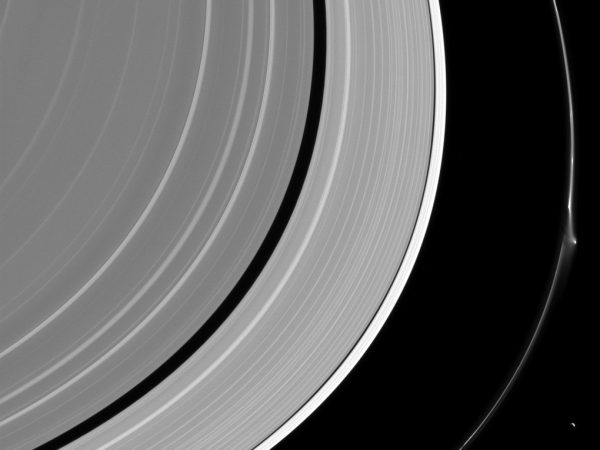A Mysterious Object Just Dented One of Saturn’s Rings
Recently, scientists regulating NASA’s Cassini spacecraft beheld a bizarre ding in one of Saturn’s rings. Saturn is sometimes called a “Jewel of a Solar System.”
Saturn’s rings are composed of trillions of particles of dust, rock, and ice circling the planet at different speeds up to thousands of kilometres per hour. The size of these particles can range from as little as a grain of sand to bigger than a skyscraper. Astronomers spotted the dent in Saturn’s F ring – which is its outermost discrete ring. Astronomers also refer ‘F ring’ as the most active ring in the solar system as they are able to observe its features shifting over the course of a few hours. The disturbance, NASA said, was possibly caused by a small object embedded in the ring.

John Weiss is currently an assistant professor of physics at St. Martin’s University Washington and previously worked at CICLOPS (CICLOPS Webite) as a ring science for the Cassini mission. Most of his research involved Saturn’s rings and their dynamical behaviours, although he worked a bit on the jets of Enceladus as well. His thesis was mainly about the edges of rings where there are no moons to constrain the particles. He suggested that:
“There’s good evidence that there’s a lot of these sized bodies in the core of the ring itself, but you can’t normally see them because they’re covered by the dust cloud around them. But they’re in there, and every so often move across the ring space and blow a bunch of those dust particles out. This one was travelling faster than 0.9 metres per second”
So when this tiny object made contact with some of the stuff in the ring’s core, it formed something that astronomers sometimes call a ‘jet’. Astronomers think that these jets are made thanks to the gravitational pull of Saturn’s small, potato-shaped moon Prometheus.
John Weiss said to National Geographic:
“Prometheus acts as a cosmic shepherd, sculpting the F ring as it makes its orbit around Saturn. But the moon’s route isn’t perfectly circular, and its uneven pull can create clumps inside the ring that then shoot out as jets.”
The impact itself actually occurred pretty recently – within a day or so of when this picture was captured on April 8, Weiss said. In the two months since the picture was captured, “The wound has just about stitched itself back up,”
“You get to expecting in planetary science for things to have happened millions of years ago, and you don’t think to ever get to observe things actively happening. But that’s the kind of funky thing with Saturn’s rings. You can actually see evidence of things that happened yesterday or the day before.”





